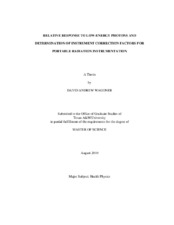| dc.description.abstract | Practically all portable radiation instruments come from the manufacturer with a
graph of photon energy response. However, many of these graphs are in log-log format
which can disguise relatively large variations in response, particularly for low-energy
photons. Additionally, many only include one specific orientation. Thus, in many cases,
it is left up to the user to determine for which orientation and photon energies the
instrument will be calibrated and ultimately used in the field. It is known that many
instruments can have inconsistent responses below ~300 keV, which may lead to under
or over-estimation of exposure rate. However, based on relative response plots, one can
derive an instrument correction factor that can be applied to the measured exposure rate
to yield a constant response curve and more accurately estimate the exposure rate.
Using a combination of irradiator systems, six different types of radiation
instrumentation were irradiated with photons with energies from 38 to 1253 keV in
various orientations. A calibrated ion chamber, in conjunction with an electrometer, was
used to determine the conventionally true exposure rates for various x-ray beam codes
and radionuclides contained in the irradiator systems. The conventionally true exposure rates were compared to the measured values for each instrument type and relative
response plots were constructed. These plots were used to determine an ideal orientation
and correction factors were chosen for responses > ±20 percent.
From the relative response plots, instrument correction factors are not necessary
for the following; Eberline RO-20, Thermo RadEye B20, and Bicron Micro Rem LE.
Correction factors of 0.7 and 1.5 should be applied for photons between 80 – 120 keV
for the Eberline Teletector 6112B low and high-range detectors, respectively. A
correction factor of 0.8 should be applied for photons below 120 keV for the Eberline
RO-7-BM. For the Thermo Mk2 EPD, a correction factor of 1.25 should be applied for
photons below 40 keV. The primary causes of under and/or over-responses were found
to be window attenuation, varying interaction cross-sections, and the range of secondary
electrons. Angular dependence and calibrations for specific applications are also
discussed. | en |


